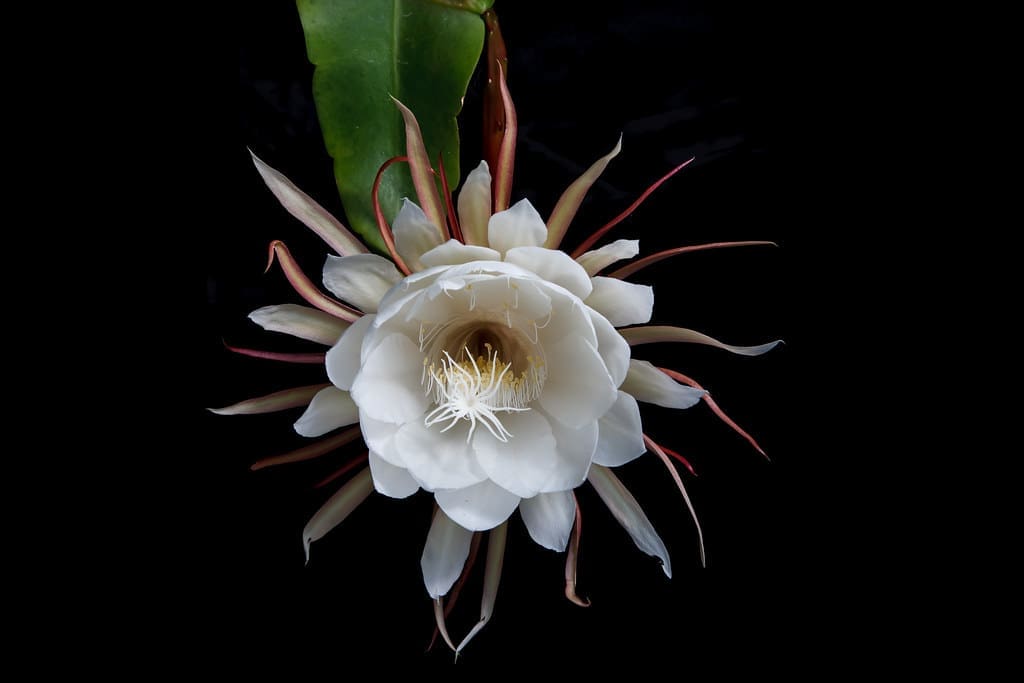
Cactus grandiflorus
Latin name: Cactus grandiflorus
Short name: Cact
Common name: Night-Blooming Cereus | Large-Flowered Cactus | Queen of the Night | Torch Cactus
Primary miasm: Sycotic Secondary miasm(s): Psoric, Tubercular
Kingdom: Plants
Family: Cactaceae
- Symptomatology
- Remedy Information
- Differentiation & Application
Cactus grandiflorus is a climbing cactus native to the tropical regions of the West Indies and Central America. Its large, fragrant, white flowers open at night and wither by morning, a botanical marvel that has inspired much folklore. The fresh stems and flowers are used for the homeopathic tincture. In crude herbal form, it has been known to possess cardiotonic properties, comparable in some ways to Digitalis, but with a distinct sphere of action on the vasculature.
In herbal traditions, used as a heart tonic, diuretic, and remedy for circulatory disorders. Known in eclectic medicine for regulating heart rhythm and improving cardiac output.
Proved by Rubini in the mid-19th century; symptoms corroborated by numerous clinical experiences (Hering, Allen, Clarke). Its sphere of action was expanded through acute observation in cases of angina pectoris, valvular disease, and menstrual disorders.
- Heart: Acts directly on the myocardium and coronary circulation, producing sensations of constriction, oppression, and irregular action.
- Blood vessels: Tends to affect both arteries and veins; marked affinity for vaso-motor spasm, congestion, and haemorrhage.
- Uterus: Menstrual disorders with a sensation as if the uterus is grasped and squeezed by an iron band.
- Nervous system: Secondary involvement through disturbed cardiac function and vascular tone.
- Open air, which seems to relieve chest oppression [Kent].
- Rest, especially lying quietly without exertion.
- Sleep, after which cardiac symptoms may be temporarily ameliorated.
- Lying on the left side, which aggravates cardiac constriction [Hering].
- Warm, stuffy rooms and physical exertion.
- Mental excitement, grief, or emotional shock.
- Menstrual periods, which intensify uterine constriction and cardiac symptoms.
- Glonoinum – Sudden rush of blood to the head, throbbing, but without the fixed constriction of Cactus.
- Spigelia – Neuralgic cardiac pains, stabbing, radiating, worse from motion; lacks the band-like constriction.
- Arsenicum album – Cardiac asthma with great restlessness and anxiety, but more burning pains and periodicity.
- Digitalis – Weak, slow pulse with faintness; no marked constriction sensation.
- Complementary: Spigelia, Digitalis.
- Antidotes: Camphor.
- Follows well: Aconite in acute inflammatory cardiac conditions.
The essence of Cactus grandiflorus is constriction and congestion—a sensation of being bound, clamped, or gripped by an unyielding force. Whether in the heart, uterus, or head, the patient feels imprisoned in their own body. Its power lies in regulating circulation, relieving spasm, and re-establishing the free flow of blood and life force.
- Valuable in angina with iron-band sensation.
- Indicated in dysmenorrhoea with constriction.
- Useful in valvular lesions with congestion.
- Often required in climacteric heart complaints.
Mind:
- Anxiety about the heart.
- Fear of death during cardiac symptoms.
Head:
- Congestion to head during heart disease.
- Headache with heart symptoms.
Chest:
- Constriction, as if iron band around chest.
- Pain, heart, radiating to left arm.
Female:
- Dysmenorrhoea with squeezing pains.
- Uterus, constriction as if by iron hand.
Generalities:
- Constriction of parts.
- Haemorrhage from congestion.
- Rubini – Original proving notes: iron-band sensation of the heart.
- Hering C. – Guiding Symptoms: Cardiac constriction and uterine symptoms.
- Allen T.F. – Encyclopaedia: Detailed proving records.
- Clarke J.H. – Dictionary of Practical Materia Medica: Clinical cardiac cases.
- Kent J.T. – Lectures: Emotional and mental states linked to heart pathology.
- Boericke W. – Pocket Manual: Concise keynotes.
- Farrington E.A. – Clinical Materia Medica: Heart and uterus sphere.
- Nash E.B. – Leaders: Cardiac constriction.
- Boger C.M. – Synoptic Key: Constriction as keynote.
- Dewey W.A. – Therapeutics: Grouping with cardiac remedies.
